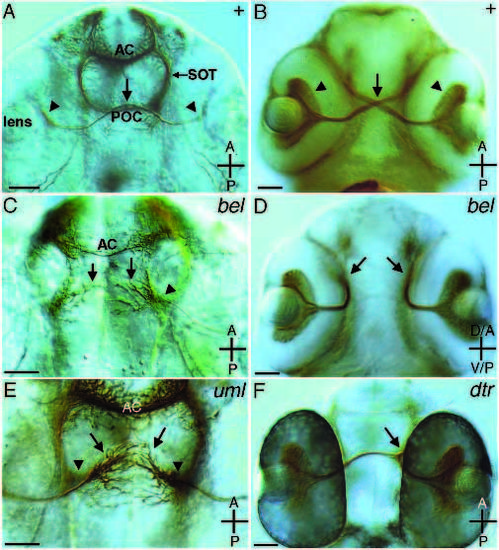
ZN-5 and anti-AT antibody labeling of wild type and mutants with ipsilateral retinotectal projections. (A, C and E) 36-hour embryos labeled with the anti-acetylated tubulin antibody that recognizes most axons. (B, D and F) 48-hour embryos labeled with the ZN-5 antibody that recognizes RGCs and their axons. (A) At 36 hours in the wild type, RGC axons have crossed the midline and grow along their contralateral counterparts (arrow). Arrowheads show retinal ganglion cell bodies. (B) At 48 hours in the wild type, the optic chiasm is well formed (arrow) and RGC axons extend to the contralateral tectal lobes. RGCs are positioned near the lens (arrowheads). (C) In belladonna mutants at 36 hours, the POC does not form (arrows), while the AC forms relatively normally. RGC axons remain near the ipsilateral eye (arrowhead). (D) In belladonna mutants at 48 hours, RGC axons project dorsally immediately after leaving the eye (arrows). (E) In some 36-hour umleitung mutant embryos, RGC axons grow toward the midline (arrows). The axons of the tract of the post-optic commissure remain lateral (arrowheads) and no POC forms. In other fish, RGC axons seem to turn dorsally immediately after leaving the eye (not shown). (F) In some detour mutant embryos, RGC axons from one eye project ipsilaterally (arrow), while those from the other eye project contralaterally. Axons can be followed to the tectal lobe on the right in this figure, while no axons project to the other tectal lobe. The result is that both eyes project to the same tectal lobe. AC, anterior commissure; POC, post-optic commissure; SOT, supraoptic tract. A, anterior; P, posterior; D, dorsal; V, ventral. Scale bars, 50 µm (A,B,D,F), 25 µm (C,E).
|

